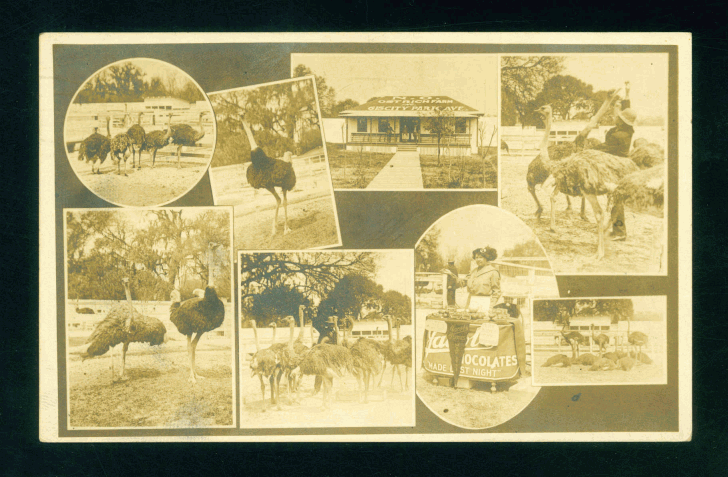|
Signs of New Orleans |
|
|
1915 Ostrich Farm |
|||||||||||||||||||||||||||||||||||||||||||||||||||||||||||||||||||||||||||||||||||||||||||||||||||||||||||||||||||||||||||||
|
|
 In 1903 the City Park Board of Commissioners announced that an ostrich farm would "Likely be located at City Park"
after a New York business proposed a 2 to 3 acre farm on undeveloped park-owned property which would be home for 40 ostriches.
This never came to be. In 1910 the board turned down a similar proposal by Jacksonville, Florida entrepreneur William
W. Ford. But in In 1914 L.M. Hughes presented a proposal to develop an ostrich farm
(50 ostriches) on one acre of undeveloped park-owned property adjoining Holt Cemetery on the upper side of the Orleans Canal
near the park's shooting range. His $40,000 investment would include the construction of pens, fences, coops, a feather
workshop, and an office building. In October 1914 the board approved the proposal with glowing praises that the farm
would make City Park more attractive and would become a "showplace and a commercial venture". By November
two acres were set aside across the Orleans Canal from the main park were adult ostriches were to be placed, eggs exhibited,
and chicks hatched and raised in what was "expected to be a great attraction" according to the local newspaper.
In February 1915 the farm finally opened as "Hughes Farm". John B. Cefalu had
organized the business appointing Hughes the vice-president and J.F. Gulacker the secretary/treasurer. With much fanfare
ostriches Antony (valued at $8000 according to Hughes) along with Cleopatra, Marcus Brutus, Portia and 48 other African ostriches
which had been transported from El Paso, Texas made their debut to the public on the far eastern edge of park property, two
blocks from the Canal Street cemeteries.
Again the City Park board members sang its praises..."expected to prove the biggest attraction the popular resort ever
has offered the people". Hughes chimed in, adding that he would "get a skilled jockey for Brutus, and show
you what the bird can do in the way of smashing speed records. There isn't a trotting or running horse that can touch
him on long or short distance". The birds enjoyed accommodations under a South African-style bungalow and in 12
pens. An ostrich egg, weighing 4.5 pounds, was on display. Admission was 10 cents. In
May advertisements began appearing in the Times-Picayune touting a sales-room and factory farm where "Old feathers [were]
made new" and a city store at 635 Canal Street. Brutus (and other male ostriches) pulled men in harnesses everyday
at 3, 4, 5, and 6 P.M. Meanwhile, at the Spanish Fort pavilion, Miss Myrtle Howard performed the "ostrich walk"
and ostrich glide" (after having spent much time at the farm observing the birds) in Uncle Hiram's Barn Dance act which
allegedly attracted 1000 to 2000 people. Eggs laid on the farm were displayed at Spanish Fort and the arrival of new
chicks was anxiously awaited but the first ostrich ever born in New Orleans hatched at the farm on the City Park property. On
Friday, November 26, 1915 a receiver's sale offered all property at 615 City Park Avenue, including the birds, chicks,
racers, wagons, harnesses, office furniture and feathers. The final fate of the New Orleans Ostrich Farm is unknown
to this researcher but In December the City Park board allowed an indefinite lease to the farm managers, noting that the enterprise
was an "educational institution". In 1916 homes for sale ads noted properties near the farm which illustrates
its popularity at the time. Note in the postcard above that the
roof reads "N.O. Ostrich Farm --615 City Park Ave".
New Orleans
Ostrich Farm Inc. 615 City Park Ave The
roof (below) reads "N.O. Ostrich Farm 615 City Park Ave. |

|
|||||||||||||||||||||||||||||||||||||||||||||||||||||||||||||||||||||||||||||||||||||||||||||||||||||||||||||||||||||||||||
|
|
|||||||||||||||||||||||||||||||||||||||||||||||||||||||||||||||||||||||||||||||||||||||||||||||||||||||||||||||||||||||||||||